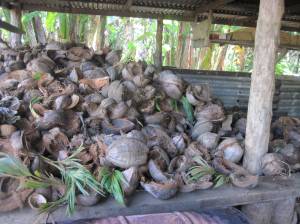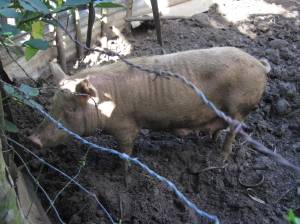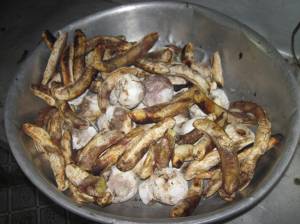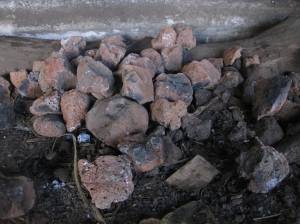From the blog Karen and Dave In Samoa
Posted March 13, 2011
This is the traditional way to cook Samoan food. I have been told that this version is not the original, but the only difference is that this one is above ground instead of below. It seems to me that being above ground improves airflow, and reduces the amount of time needed to “fai le umu” {make the umu}.

Coconut and Husks
First, a small fire is made with empty coconut shells. Our family uses 5 halves of coconuts. They are stacked like a pyramid 4 on bottom and one on top. A burning piece of cardboard, paper, or whatever is put under the top shell and fed until it lights. Once the top shell is lit, wood and coconut husks are added. The wood is just for fuel. The husks are placed around the edge of the umu in an effort to keep the heat closed inside.
Once the wood and husks are stacked high enough, lava rocks are used to cover the firewood. The fire burns amazingly well considering how choked for air it is. Once the wood has all burned to coal the rocks are removed and the food to be cooked is placed on the base level of rocks. Putting the food in the umu takes about 1 or 2 minutes maximum.
Lava rocks
Then the lava rocks are hastily put on top of the food, and then the whole thing is covered in banana leaves, mats, and whatever else is lying around that is large and flattish. Depending on how hot the rocks got, the food cooks for 20 – 40 minutes. To take the food out, the rocks are all removed and the food is placed into baskets woven from coconut fronds.

Banana Leaves
That is the most basic explanation of how to make the umu. Depending on what is cooked in the umu hours are spent preparing the food.

Finished Umu
A pig before going into the umu has to be slaughtered, gutted, skinned, cleaned, and stuffed. I have seen this done is as little as 25 – 30 minutes.

Size 4 Pig
Palusami is an event. First coconuts, banana leaves, breadfruit leaves, and baby taro leaves have to be collected. The breadfruit and banana leaves are placed on the hot umu rocks for a few seconds to weaken them. The Taro leaves have the hard ends pulled off. The coconuts are husked, cracked in half, the flesh is then scraped out into a bowl, and then is hand squeezed to make coconut milk. Cut onions and salt are added to the coconut milk. Four taro leaves are placed in your left hand formed into a bowl or cup shape. Then coconut milk is poured in. Next the taro leaves are formed into a ball with the liquid inside and wrapped in a banana leaf. Then a single breadfruit leaf is wrapped around that. One palusami will feed 1 person, and they might want a second one. Palusami is used as a dipping sauce/paste for taro, breadfruit, and cooked bananas.

Palusami is the green ball on the right
“Ulu” {Breadfruit}, “talo” {taro}, and “fa’i”{green bananas} all need to be peeled. The peeler of choice for breadfruit and taro is an old tin can. The green bananas get a special flat stick. There are other foods that go in as well such as “moa” {chicken} “mamoe” {mutton (adult lamb)}“povi” {beef} and “i’a” {fish}. They all take a great deal of time to prepare.

Fa’i and Talo
On Sundays there is the traditional “to’ona’i” {Sunday meal} and an umu is always made for this event. to’ona’i is held after the morning church service. So 10:30 – 11 am is a normal time for theto’ona’i to start. The guys who fai le umuget up at 4 or 4:30 am to start making it so it is ready in time. No, they do not attend the service they are still cooking then.
Our family also has a home made oven built from cement and a 50 gallon drum. This lets them bake more sensitive things like breads, pies, and scones.

Electric free oven
You can follow Karen’s journey in Samoa through her blog Karen and Dave In Samoa

